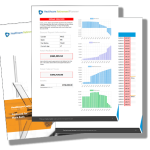When it comes to versatile financial planning tools, understanding what is an IUL, Indexed Universal Life Insurance (IUL) , policy can be invaluable. As a powerful combination of life insurance and investment vehicle, IULs offer unique benefits for individuals seeking long-term wealth accumulation and protection.
In this blog post, we will dive deep into the key components of these policies and how interest rates are determined within them. Furthermore, we’ll explore the tax-free growth potential that makes these policies attractive for retirement planning purposes while discussing strategic cash value withdrawals.
However, as with any financial product, there are drawbacks and risks associated with IUL policies. We’ll compare fees between different types of life insurances and assess the risks involved in investing through an IUL policy.
Finally, we’ll examine how leveraging Indexed Universal Life Insurance can help mitigate Medicare’s Income-Related Monthly Adjustment Amount (IRMAA), offering strategies for reducing taxable income using IULs. In addition to that, we will provide guidance on monitoring and managing your IUL policy over time to ensure optimal performance.
This comprehensive guide aims to answer all your questions about what is an IUL so you can make informed decisions when considering this type of insurance product as part of your overall financial strategy.
Indexed Universal Life Insurance Explained
What is an IUL? Indexed Universal Life (IUL) insurance is a type of life insurance policy that combines the flexibility of universal life insurance with an investment component tied to market indices. It accumulates cash value and provides a death benefit, making it an attractive option for those looking to build wealth while also providing financial protection for their loved ones.
The Structure and Components of IUL Policies
IUL policies consist of two main components: the cost of insurance (COI) and the cash value accumulation. The COI covers mortality charges, policy administration fees, and other expenses associated with maintaining your coverage. On the other hand, the cash value accumulation grows over time based on interest earned from either fixed interest rate accounts or indexed accounts linked to market indices such as S&P 500 or Nasdaq 100.
Cash Value Accumulation through Fixed Interest Rate Accounts or Indexed Accounts
In an IUL policy, you have the option to allocate your premiums between fixed interest rate accounts and indexed accounts. Fixed interest rate accounts offer a guaranteed minimum return on your investment but may provide lower returns compared to indexed account options. Indexed account returns are based on changes in specific market indices but typically come with caps limiting maximum gains during strong market performance periods while still offering some downside protection when markets perform poorly.
- Fixed Interest Rate Accounts: These offer stable growth potential by earning a predetermined annual percentage yield set by the insurer.
- Indexed Accounts: They allow you to participate in potential stock market gains without directly investing in stocks themselves; however, they often include participation rates determining how much index-linked growth will be credited to your IUL cash value.
It’s important to note that while IUL policies offer potential for higher returns compared to traditional whole life insurance, they also come with increased risks due to their direct connection with market performance. As a financial professional, understanding the intricacies of IUL policies can help you better advise clients on whether this type of coverage is suitable for their needs and long-term goals.
Key Takeaway:
Indexed Universal Life (IUL) insurance is a life insurance policy that combines universal life insurance with an investment component tied to market indices. It offers the option to allocate premiums between fixed interest rate accounts and indexed accounts, but comes with increased risks due to its direct connection with market performance. Financial professionals should understand the intricacies of IUL policies in order to advise clients on whether this type of coverage is suitable for their needs and long-term goals.






